Facts about Fuji

The modern, "New Fuji" is believed to have formed over the top of Old Fuji by around ten thousand years ago.

Valuable data on the activity of Mount Fuji, exhibiting a range of representative eruptions, is recorded in Japanese historical documents dating from the eighth century onwards.

An estimated 200,000 people climb Mount Fuji every year, 30 percent of which are foreigners.

Concerns increased following the earthquake and tsunami in 2011, and readings indicated that pressure in Mount Fuji's magma chamber had increased to a level that suggested an eruption was imminent.
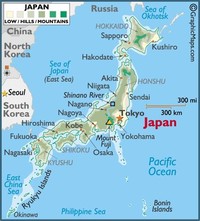
At this time, Mount Fuji is located at the point where the Eurasian Plate (or the Amurian Plate), the Okhotsk Plate, and the Philippine Plate meet.

Mount Fuji has five lakes around it: Lake Kawaguchi, Lake Yamanaka, Lake Sai, Lake Motosu and Lake Shoji.

Fuji-san is sometimes referred to as Fuji Yama in some Western texts, because the third character of its name (?, meaning mountain) can also be pronounced "yama."

In 684 (the sixth year of the J?gan era) there was an eruption on the northeast side of Mount Fuji, which produced a great amount of lava.

Ash from New Fuji is often black, and eruptions are new in terms of geological layers.

There has been volcanic activity in the vicinity of Mount Fuji for several million years.

Under the "New Fuji volcano" lie the "Komitake volcano," and the "Old Fuji volcano."

Scientists have identified four distinct phases of volcanic activity in the formation of Mount Fuji.

The mountain as it appears now is the "New Fuji volcano," which began to erupt about 10,000 years ago.

After a visit in 1995, UNESCO representatives concluded that although Mount Fuji was worthy of World Heritage listing, Japan first would have to solve the pollution problems and implement an effective management plan.

Four centuries later, Fuji-ko, societies devoted to the worship of Fuji, became a major religious movement and inspired thousands of people to embark on annual pilgrimages.
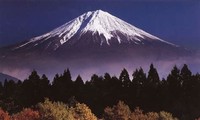
In 2007, Mount Fuji was again submitted to UNESCO for World Heritage listing, as a cultural (rather than natural) site.

Research on the distribution of place names that include Fuji also suggest the origin of the word fuji is in Yamato language rather than Ainu.

About 700,000 years ago, in the location occupied by the current Mount Fuji, a volcano known as Mount Komitake (?????, "small mountain volcano"), became active.
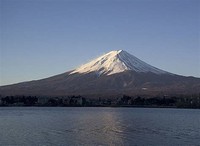
Experts cannot predict when the next eruption of Mount Fuji will occur.

Aokigahara, a forest lying at the base of Mount Fuji, is the subject of many legends about monsters, ghosts, and goblins haunting the forest.
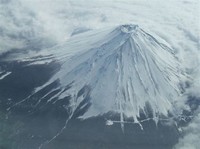
The summit was forbidden to women until the Meiji era; today almost half of those climbing Mount Fuji are women.
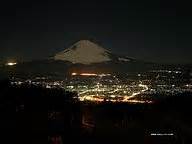
A Japanese toponymist Kanji Kagami argued that the name has the same root as 'wisteria' (fuji) and 'rainbow' (niji, but with an alternative word fuji), and came from its "long well-shaped slope."

Fuji-ko members maintain her altars in their homes, and each group lights a torch in her honor at the fire ceremony.

Mount Fuji is surrounded by myths and legends concerning its spiritual significance and resident spirits and deities.

The peak of the ancient volcano, Komitake, can be seen from the north face of Mount Fuji at the fifth station, about 2,300 meters above sea-level.

During the Tokugawa period (1600-1868) the Fuji-ko (Fuji mountain-climbing movement) confirmed her as the principal goddess of the mountain.

Buddhists found in Fuji an inspiring symbol of meditation and called its summit “zenjo,” a Buddhist term describing a perfect meditative state.

Murayama trail is the oldest Mount Fuji trail, and Yoshida trail still has many old shrines, teahouses, and huts along its path.
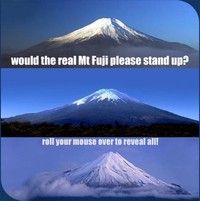
Approximately 100,000 years ago, "Old Fuji" was formed over the top of Komitake Fuji.
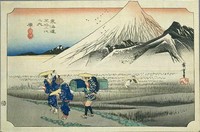
The most renowned work is Ukiyo-e painter Hokusai's masterpiece, 36 Views of Mount Fuji.
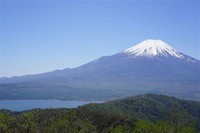
The soaring volcanic cone of Mount Fuji has been a frequent subject of Japanese art.

Mount Fuji is also an important religious center; nearly two thousand religious organizations are based around the mountain, including one of Japan’s largest Buddhist sects.

Eruptions of New Fuji exhibit phenomena such as lava flows, magma, scoria, volcanic ash, collapses and side eruptions.

Mount Fuji (???; Fuji-san in Japanese) is the tallest volcano and the highest mountain in Japan.

The current volcano, which erupted about ten thousand years ago, covers two older volcanos, Komitake Fuji and Old Fuji.

Sen-komitake was followed by the "Komitake Fuji," a basalt layer believed to have been formed several hundred thousand years ago.

Three small cities surround it, Gotemba (East), Fuji-Yoshida (North) and Fujinomiya (Southwest).

Buddhists also came to regard Fuji as the abode of the Buddha of All-Illuminating Wisdom.
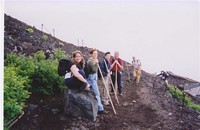
The most popular period for people to hike up Mount Fuji is from July 1 through August 27, while huts and other facilities are operating.

Sometime between the fourteenth and sixteenth centuries the belief arose that Konohana Sakuya Hime could protect the villages around Mount Fuji as she had protected her son.

An early folk etymology claims that Fuji came from (??, not + two), meaning without equal or nonpareil.

